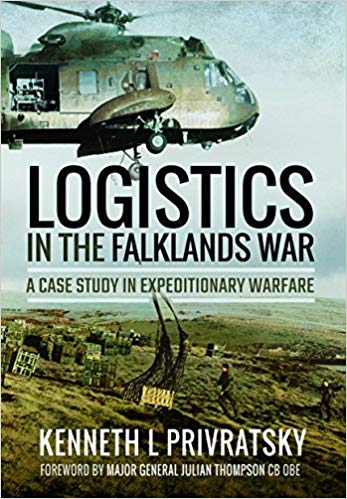“Logistics in the Falklands War – A Case Study in Expeditionary Warfare” by Major General Kenneth Privratsky, USA (ret)

World travel connects one to history. Touring an area where an event took place makes it much more meaningful – especially when the event happened within your lifetime. Thus was I very impressed with a daylong visit to the Falkland Islands as part of a cruise taken a few years ago. I remembered the Falklands War at the time and the visit inspired me to research more about it. Imagine the thrill of finding a book not only about the war itself but also about the Logistics of it!
The British had acquired the Falklands as part of their empire and it was a convenient coaling station for ships traveling around the horn to the Pacific Ocean back when ships burned coal. The inhabitants were and are still fiercely British and the main industry was raising sheep. However, Argentina felt that the islands just off their coast were part of their territory and when a military junta took power, they decided a means of winning the Argentine citizens to their side was to capture the Malvina Islands, their name for the Falklands. The convenient retirement without replacement of the only British warship (an icebreaking supply vessel) in the area gave them their chance and the elite Argentine soldiers landed on the islands quickly overpowered the 60 or so British garrison troops. Argentina gambled that the British did not have the means or the will to move forces 8000 miles into the South Atlantic to take the islands back. Some interesting points from the book:
~ The British had no bases in the area from which to operate. The only forward base was Ascension Island, roughly 4000 miles from both Britain and the Falklands, with an airfield and limited other facilities. For a time this airfield became the busiest airport in the world.
~ The British had a professional army but not much means to deploy them. The army/marine units were set up to support NATO in Europe. They had few landing craft and logistical ships and even some of them had to be brought back from retirement.
~ The British had logistics units built into their army/marine commands which functioned well. They figured out what was needed and it was supplied but since the goal was to get moving South as soon as possible, supplies were just crammed into the first available spaces on any ship without regards to how they would be used or who would use them. Considerable resorting took place as the force sailed South and even then not everything was available as needed. A lot of helicopter life was used up in this work.
While Argentine elite troops captured the islands, they were garrisoned mostly with conscript, poorly trained troops. While adequate supplies were pushed out to the islands to support them, due to nature of the islands (see below) it was very difficult to get supplies out to the troops in the field. Troops in the field were starving while plenty of food sat in Port Stanley.
~ Britain sent both of their aircraft carriers to the Falklands to provide needed air cover. Despite this, they were never able to achieve air supremacy and their ships and troops were under constant air attack from aircraft dispatched from mainland Argentina. This cost the British dearly in ships and lives lost.
An interesting story within all this was an opportunity that popped up for the British to establish a base to the South of Port Stanley, their ultimate objective. Scouts informed the leadership that no Argentine soldiers were in that area so a unit was quickly delivered there by helicopter. Once there, however, with minimal supplies, the problem was how to keep them there and properly supplied. Ultimately two supply ships had to be dispatched to that area to support them. This put the ships in full view of the Argentines in daylight and the ships were attacked by aircraft with heavy loss of life. We happened to tour this area on a penguin viewing excursion and were quite shocked when we realized the depressions all around the penguin colony were shell craters from the war.
I highly recommend this book not only as a very detailed account of the war itself but also the logistical efforts that had to go on behind the scenes to make the efforts possible. In addition, A Very Strange Way to Go to War – The Canberra in the Falklands by Andrew Vine is another interesting book about the war. While not as logistically oriented, it provides a detailed glimpse into life on a British cruise ship suddenly commandeered for war, quickly converted to haul troops and land helicopters, overloaded with supplies and sent into the midst of the fighting where it was never intended to go.
Even 30 years later, the war is still very much a part of life on the Falklands. A new British garrison with large airfield and many more troops is a new way of life. Also, numerous Argentine laid mine fields are marked and still being slowly cleared – indeed, we passed right next to an active clearing operation alongside the road while we toured. Both British and Argentine troops are buried on the islands – the former not repatriated and the latter buried on what is still considered Argentine soil. – George
